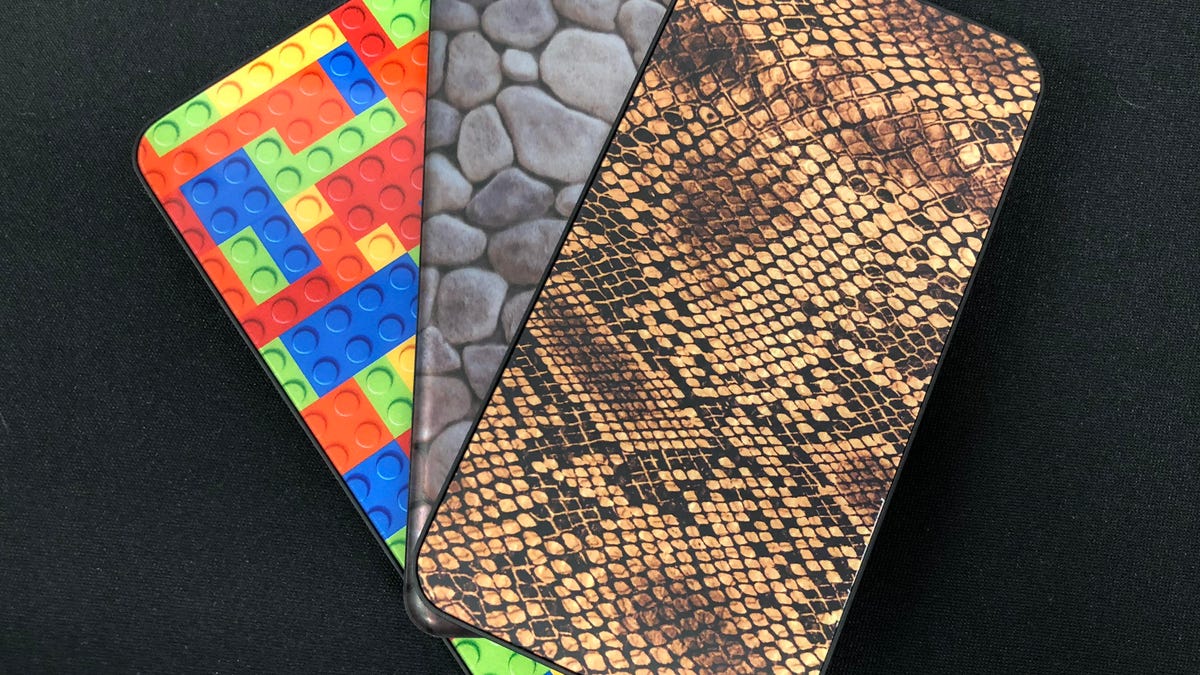Goodbye smudges. For Gorilla Glass phones, matte could be the new black
A new Corning technology can etch designs -- one day, maybe even a photo of your dog -- onto the back glass panel of a phone.

Fingerprint-smudged smartphones may soon be a thing of the past, thanks to new technology from glass maker Corning .
Handset vendors like Apple and Samsung have been incorporating more and more glass in their phone designs over the past couple of years. While devices originally had glass just over the front touchscreen, designs now contain glass that curves around the edges of the phone and sometimes covers the entire back of the device.
This year, about 28 percent of all phones sold -- and nearly 100 percent of pricey, high-end phones -- will have glass on the back of the device, said John Bayne, general manager of Corning's Gorilla Glass business.
"We're seeing glass on the back because glass supports wireless charging and higher data rates like 5G, and metal is on the wrong side of the technology curve," Bayne said in an interview Wednesday after a Corning press event in Sunnyvale, California.
But incorporating glass on the back of devices has meant a lot more fingerprints and scratches.
Corning says it has a workaround for all of those smudges. It's developed technology to etch designs on its glass using a special inkjet printer, giving the glass a matte finish instead of a shiny one. While the process doesn't actually remove fingerprints, it does make them significantly less noticeable. And it also makes the phone less slippery and more grippy, Bayne said.
Goodbye fingerprints, hello texture
When you touch a piece of glass, your fingers leave behind oil that bends the light differently than untouched glass. That's what gives you the ugly smudges on your device. Etching the glass's surface causes a sort of blurring that minimizes the appearance of fingerprints.
PC makers like Acer and Lenovo already have rolled out computers that use Corning's matte etching on their laptop covers. But no handset makers have yet signed up for the technology, called Vibrant Satin Corning Gorilla Glass. That's largely because they're still figuring out how they'd actually roll it out, or what they'd charge for it, Bayne said.
"There are no imminent product launches," he said. "We don't have that anchor customer yet."
It's expensive for a handset maker to release a wide variety of colors for a device or to customize models for individual customers. If the company misjudges demand for a certain variant, it could be stuck with unneeded inventory, but it's pricey to build just a small quantity of specialized models. Some companies have allowed users to customize their devices, as in the case of Motorola's Moto X phones. But it's more common for people to personalize their phones by buying cases.
Corning's Gorilla Glass can be printed with a matte finish to minimize the appearance of fingerprints and other smudges and make it more grippy.
Corning's Satin technology could allow phone makers to go even further than applying matte finishes. It's capable of printing "photorealistic images" directly onto the glass, which means those pictures of your kids or dogs could be etched onto your phone instead of just on your case. But it's another instance of the companies having to figure out how much extra they'd have to charge for the feature.
"People spend $35, $40, $50 on a case, a customized case, so [would] they pay an extra $5 or $10 to have their phone customizable on the back as well as that screensaver picture?" Bayne said. "I think so."
The next step is combining the photorealistic images with etching "to make the image feel the way it looks," he said. One example Corning showed was a snakeskin design that actually felt like snakeskin, as well as a Lego design and another riverbed with small stones. "When you touch it, it actually feels like a very smooth river stone," Bayne said.
Cutting out the sparkle
Don't think Corning's forgotten about the front display of the phone. It's working on minimizing fingerprints on the touchscreen, but there's one big, limiting problem: sparkle. Because the glass has to be transparent, it's more difficult to make smudge-proof while avoiding that unwanted shine.
Corning's new etching technology can make images on the back of phones that feel the way they look, like snakeskin or Legos.
"If you made the front of the display with a matte finish, with that great tactile feel, and the fingerprints disappear because of the way the technology works, you get a little bit of sparkling on the display itself, and that's obviously unacceptable," Bayne said.
He noted that getting a matte finish while cutting out the sparkle is "a very tough technical problem" the industry's faced for about 100 years.
"But we're getting closer and closer," Bayne said. "I think you could probably see in the future an opportunity to provide surfaces with anti-reflection, anti-glare and very good fingerprint performance. We're just not there yet."
Tech Enabled: CNET chronicles tech's role in providing new kinds of accessibility.
Blockchain Decoded: CNET looks at the tech powering bitcoin -- and soon, too, a myriad of services that will change your life.

